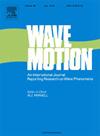Optimization of vibration and noise reduction in sigmoid functionally graded plates using mode localization
IF 2.1
3区 物理与天体物理
Q2 ACOUSTICS
引用次数: 0
Abstract
The acoustic and vibrational properties of thin plates made of aluminum and aluminum oxide with a sigmoidally functionally graded material (SFGMs) with physical neutral surface are investigated in this study through use of mode localization and varying boundary conditions. This approach facilitates an in-depth analysis of how differences in material gradation impact the vibrational response and sound emission of the plates. The materials follow a sigmoidal gradation law with indices of k = 0, 1, 5, and 10. Mode localization is assessed by imposing a 20% mass constraint, either concentrated at a point or distributed across the structure. With the use of MATLAB, the governing equation – which was derived using Kirchhoff’s plate theory – is analytically solved to determine the normal velocity and far-field sound radiation fields. Numerical simulation in ANSYS are used to validate the sound power levels, and the result shows a notable level of agreement. The ‘A’-weighted sound power levels (dBA) indicate a rise in sound power level as the sigmoid-law index increases. Across all gradation indices, plates with distributed mass exhibit reduced sound power levels compared to those with point mass. This research delivers a comprehensive analysis of the vibroacoustic properties of SFGM plates, offering important insights for designing quieter structural components in engineering applications.
基于模态定位的s型功能梯度板减振降噪优化
本文利用模态局域化和不同的边界条件,研究了具有物理中性表面的s型功能梯度材料(SFGMs)铝和氧化铝薄板的声学和振动特性。这种方法有助于深入分析材料级配差异如何影响板的振动响应和声发射。材料遵循指数为k = 0,1,5和10的s型级配规律。通过施加20%的质量约束来评估模态局部化,要么集中在一个点上,要么分布在整个结构上。利用MATLAB软件对利用基尔霍夫板理论导出的控制方程进行解析求解,确定了法向速度和远场声辐射场。在ANSYS软件中进行了数值模拟,验证了声功率级的正确性。“A”加权声功率级(dBA)表明声功率级随着s型律指数的增加而上升。在所有分级指数中,分布质量板的声功率级比点质量板的声功率级低。本研究对SFGM板的振动声学特性进行了全面的分析,为工程应用中设计更安静的结构部件提供了重要的见解。
本文章由计算机程序翻译,如有差异,请以英文原文为准。
求助全文
约1分钟内获得全文
求助全文
来源期刊

Wave Motion
物理-力学
CiteScore
4.10
自引率
8.30%
发文量
118
审稿时长
3 months
期刊介绍:
Wave Motion is devoted to the cross fertilization of ideas, and to stimulating interaction between workers in various research areas in which wave propagation phenomena play a dominant role. The description and analysis of wave propagation phenomena provides a unifying thread connecting diverse areas of engineering and the physical sciences such as acoustics, optics, geophysics, seismology, electromagnetic theory, solid and fluid mechanics.
The journal publishes papers on analytical, numerical and experimental methods. Papers that address fundamentally new topics in wave phenomena or develop wave propagation methods for solving direct and inverse problems are of interest to the journal.
 求助内容:
求助内容: 应助结果提醒方式:
应助结果提醒方式:


